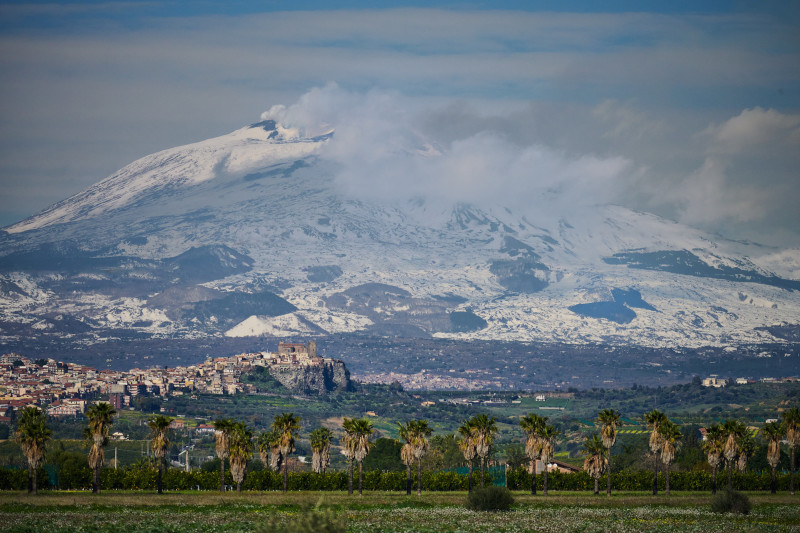
Mount Etna Facts
- The surprisingly simple term of Mount Etna serves as the english language name, and perhaps best known one, for this natural marvel. Yet, it has others by which it’s known, occurring in different tongues. These include Mongibello, Aetna, and Gibilmanna, among many others.
- This incredible geological feature stands out from similar one’s around the world. It also does so in a wide variety of ways. Physically, it’s one of the tallest peaks of its type on its entire continent. The site also actually played an important role in the early mythology of the area.
- Despite its close proximity to regions now densely populated, it’s actually an active volcano! In fact, this marvel ranks among the most active one’s on its continent. Though generally comparatively mild in nature, it remains in an almost constant state of volcanic activity.
- There’s no doubt in the minds of historians that prehistoric man knew of the existence of Mount Etna, of course. In more modern times, however, the Greek civilization made the first written mention of it. Evidence indicates that this event occurred around the year 7 BCE.
- Due to its unusual mixture of both potential danger and historical importance, it’s received a unique combination of special recognitions. Because of the threat it poses to nearby populations, it’s been named a Decade Volcano. Yet, this wonder’s also a World Heritage Site.
Related Articles
Mount Etna Physical Description
The magnificent Mount Etna almost instantly draws the eye of nearly everyone who ventures to visit it. Though the appeal varies from person to person, it holds a wide range of them. Among those, of course, stands the sheer physical size of this creation of still ongoing volcanic processes.
The height of the visually impressive volcano itself actually changes on a regular basis, of course. This takes place due to the steadily occurring volcanic activity within its confines. Currently, though, the highest measured point of the marvel stands approximately 10,922 ft (3,329 m) tall.
Classifying as a stratovolcano, it’s characterized by its relatively steep sides. These aspects formed from multiple layers of hardened lava, volcanic ash, and other related debris. In turn, these layers became built up over time through successive eruptions of widely varying strength and duration.
It’s also world renowned for yet another remarkable feature. That’s the presence of several craters, with those found on the summit itself being the most prominent. These basins commonly vary in size and activity levels, with the Southeast Crater being one of the most active in recent years.
The extraordinary Mount Etna further astounds the viewer due to the volume of land the amazing mountain covers. Due to its gently sloping nature and width, it covers an astonishing area of 459 sq mi (1,190 sq km). Its base circumference alone equals roughly an incredible 87 mi (140 km).
Mount Etna Location, Formation, and History
The stunning Mount Etna formed in a region of the globe already well known for its mind-boggling abundance of natural marvels. Many of these, in fact, have similar natures, being either volcanic or geothermal in their nature. This geological beauty lies on an island extremely close to Europe.
More precisely, powerful natural processes created this marvel on the island of Sicily. The beautiful island itself sits just off the southern tip of the country of Italy. On the island itself, though, the mountain resides on the general east coast, situated very near the cities of Catania and Messina.
Research indicates that the formation of this wonder of natural forces began long ago, roughly 500,000 years in the past. At that time, however, the activity was occurring beneath the sea. Then, about 200,000 years later, still more activity took place, relocated southwest of the summit.
Subsequently, the same processes moved once again, to what’s now its present location. This eventual displacement took place around 170,000 years in the past. At that time, ongoing eruptions built up much of the bulk of its structure, creating the general stratovolcano structure it has today.
In modern times, however, Mount Etna hasn’t ceased its active nature. In fact, it’s continued to remain active, with varying degrees of strength. During the reigns of the different civilizations of the region, countless eruptions, both major and minor in strength, occurred, most going unrecorded.
This marvel of Nature ranks as the most active volcano in Europe. Since the year 1750, seven recorded eruptive episodes have lasted longer than five years! Only Mount Vesuvius exceeds that. Fortunately, most are not greatly destructive in nature, given its location and public awareness.
Features Sharing Its Region
Check out our other articles on 4 Washington State Herbaceous Plants, Southern Elephant Seal, Deception Island, Rose’s Ghost Frog, Royal poinciana, Blue-winged Wasp, Black Mamba
